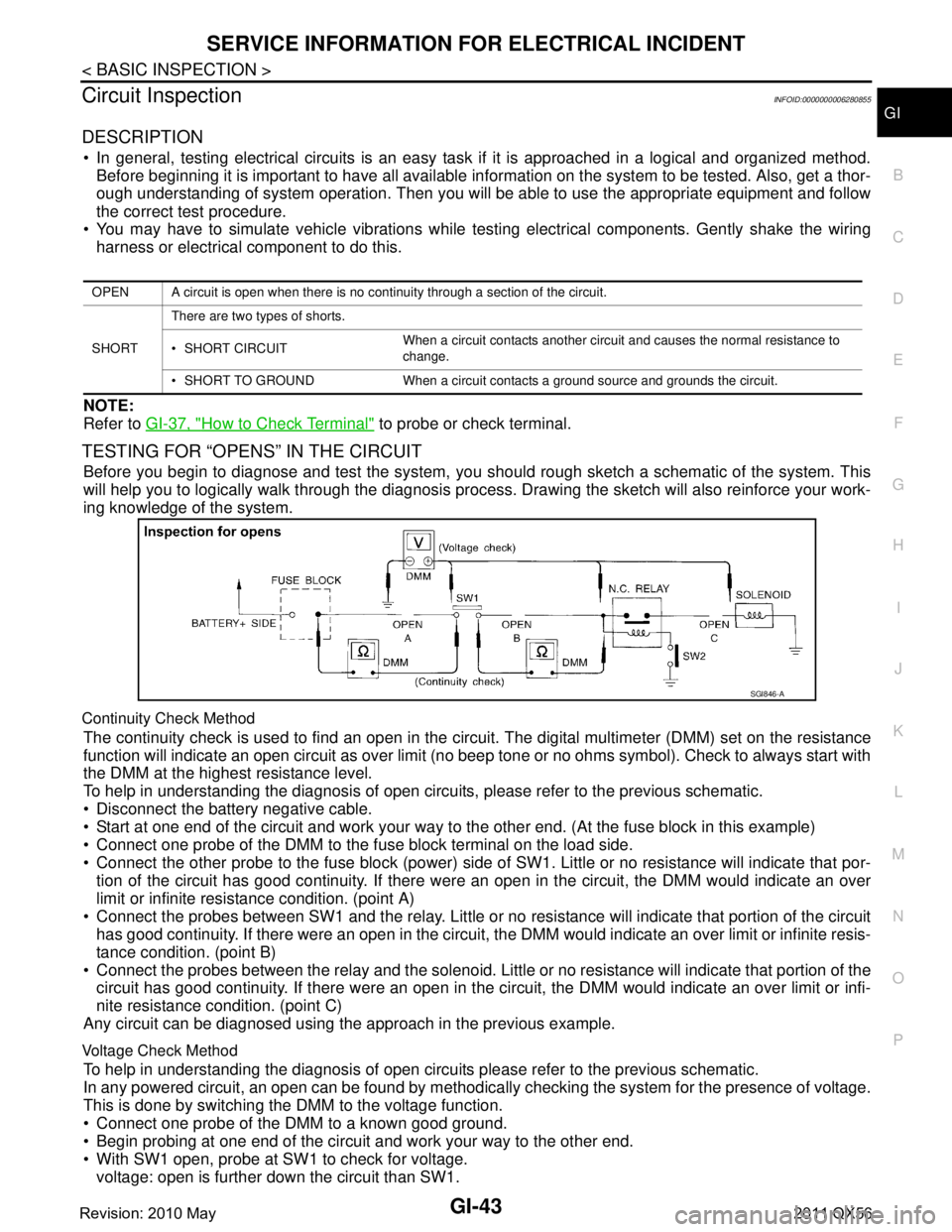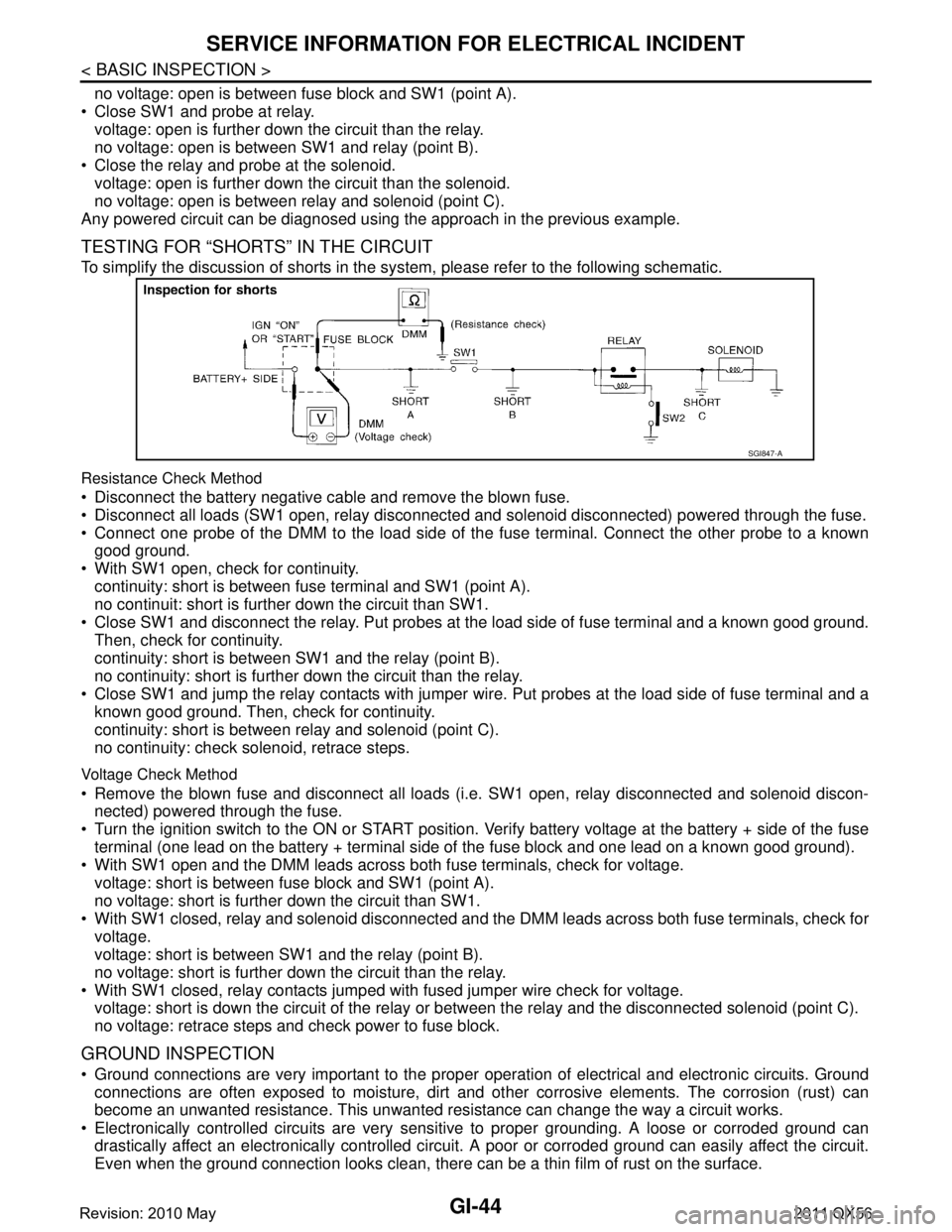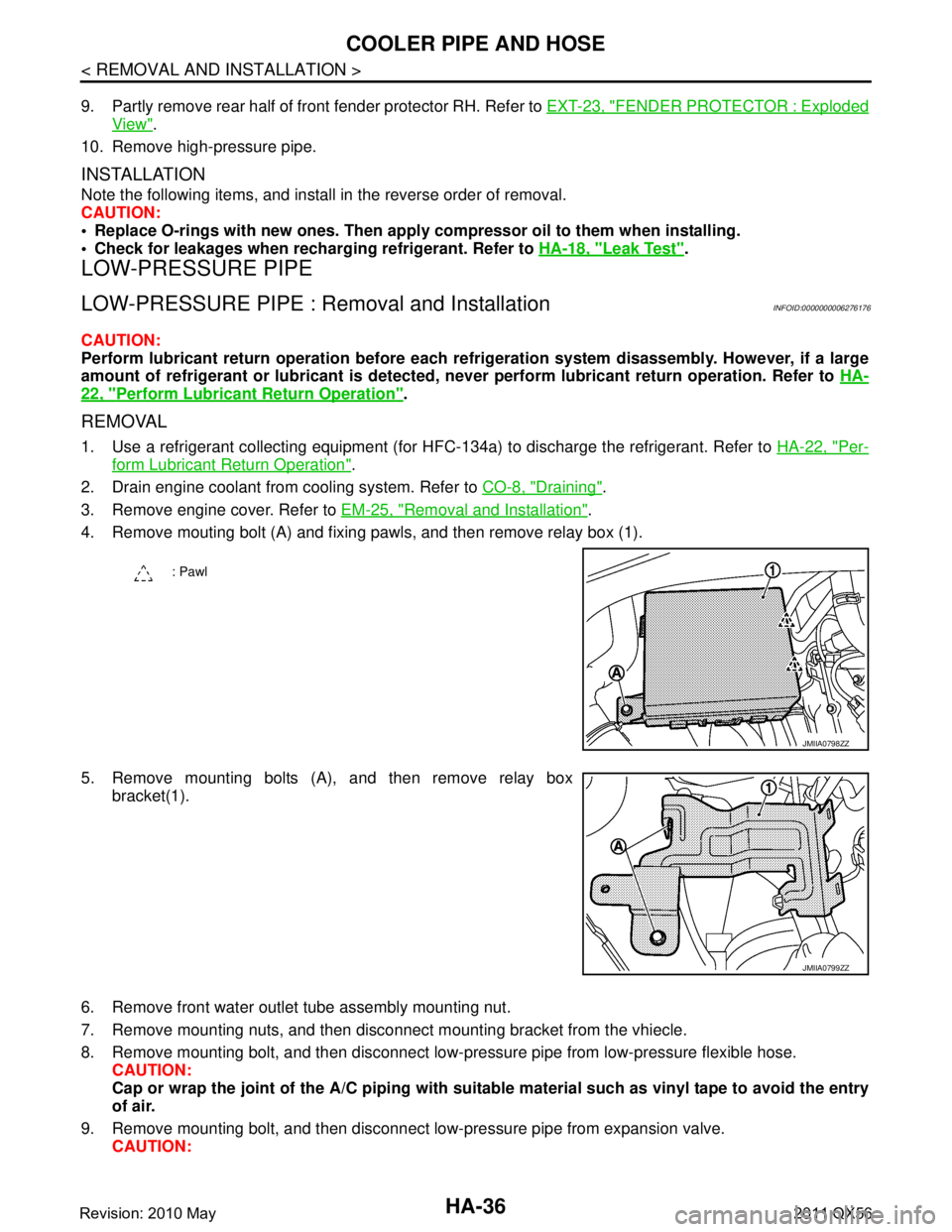2011 INFINITI QX56 relay
[x] Cancel search: relayPage 3007 of 5598

SERVICE INFORMATION FOR ELECTRICAL INCIDENTGI-43
< BASIC INSPECTION >
C
DE
F
G H
I
J
K L
M B
GI
N
O P
Circuit InspectionINFOID:0000000006280855
DESCRIPTION
In general, testing electrical circuits is an easy task if it is approached in a logical and organized method. Before beginning it is important to have all available information on the system to be tested. Also, get a thor-
ough understanding of system operation. Then you will be able to use the appropriate equipment and follow
the correct test procedure.
You may have to simulate vehicle vibrations while te sting electrical components. Gently shake the wiring
harness or electrical component to do this.
NOTE:
Refer to GI-37, "
How to Check Terminal" to probe or check terminal.
TESTING FOR “OPENS” IN THE CIRCUIT
Before you begin to diagnose and test the system, you should rough sketch a schematic of the system. This
will help you to logically walk through the diagnosis process. Drawing the sketch will also reinforce your work-
ing knowledge of the system.
Continuity Check Method
The continuity check is used to find an open in the circui t. The digital multimeter (DMM) set on the resistance
function will indicate an open circuit as over limit (no beep tone or no ohms symbol). Check to always start with
the DMM at the highest resistance level.
To help in understanding the diagnosis of open circui ts, please refer to the previous schematic.
Disconnect the battery negative cable.
Start at one end of the circuit and work your way to the other end. (At the fuse block in this example)
Connect one probe of the DMM to the fuse block terminal on the load side.
Connect the other probe to the fuse block (power) side of SW1. Little or no resistance will indicate that por-
tion of the circuit has good continuity. If there were an open in the circuit, the DMM would indicate an over
limit or infinite resistance condition. (point A)
Connect the probes between SW1 and the relay. Little or no resistance will indicate that portion of the circuit
has good continuity. If there were an open in the circuit, t he DMM would indicate an over limit or infinite resis-
tance condition. (point B)
Connect the probes between the relay and the solenoid. Little or no resistance will indicate that portion of the
circuit has good continuity. If there were an open in the ci rcuit, the DMM would indicate an over limit or infi-
nite resistance condition. (point C)
Any circuit can be diagnosed using the approach in the previous example.
Voltage Check Method
To help in understanding the diagnosis of open circui ts please refer to the previous schematic.
In any powered circuit, an open can be found by methodica lly checking the system for the presence of voltage.
This is done by switching the DMM to the voltage function.
Connect one probe of the DMM to a known good ground.
Begin probing at one end of the circuit and work your way to the other end.
With SW1 open, probe at SW1 to check for voltage. voltage: open is further down the circuit than SW1.
OPEN A circuit is open when there is no continuity through a section of the circuit.
SHORT There are two types of shorts.
SHORT CIRCUIT
When a circuit contacts another circuit and causes the normal resistance to
change.
SHORT TO GROUND When a circuit contacts a ground source and grounds the circuit.
SGI846-A
Revision: 2010 May2011 QX56
Page 3008 of 5598

GI-44
< BASIC INSPECTION >
SERVICE INFORMATION FOR ELECTRICAL INCIDENT
no voltage: open is between fuse block and SW1 (point A).
Close SW1 and probe at relay. voltage: open is further down the circuit than the relay.
no voltage: open is between SW1 and relay (point B).
Close the relay and probe at the solenoid. voltage: open is further down the circuit than the solenoid.
no voltage: open is between relay and solenoid (point C).
Any powered circuit can be diagnosed using the approach in the previous example.
TESTING FOR “SHORTS” IN THE CIRCUIT
To simplify the discussion of shorts in the sy stem, please refer to the following schematic.
Resistance Check Method
Disconnect the battery negative cable and remove the blown fuse.
Disconnect all loads (SW1 open, relay disconnected and solenoid disconnected) powered through the fuse.
Connect one probe of the DMM to the load side of the fuse terminal. Connect the other probe to a known
good ground.
With SW1 open, check for continuity. continuity: short is between fuse terminal and SW1 (point A).
no continuit: short is further down the circuit than SW1.
Close SW1 and disconnect the relay. Put probes at the load side of fuse terminal and a known good ground. Then, check for continuity.
continuity: short is between SW1 and the relay (point B).
no continuity: short is further down the circuit than the relay.
Close SW1 and jump the relay contacts with jumper wir e. Put probes at the load side of fuse terminal and a
known good ground. Then, check for continuity.
continuity: short is between relay and solenoid (point C).
no continuity: check solenoid, retrace steps.
Voltage Check Method
Remove the blown fuse and disconnect all loads (i .e. SW1 open, relay disconnected and solenoid discon-
nected) powered through the fuse.
Turn the ignition switch to the ON or START position. Verify battery voltage at the battery + side of the fuse
terminal (one lead on the battery + terminal side of the fuse block and one lead on a known good ground).
With SW1 open and the DMM leads across both fuse terminals, check for voltage. voltage: short is between fuse block and SW1 (point A).
no voltage: short is further down the circuit than SW1.
With SW1 closed, relay and solenoid disconnected and the DMM leads across both fuse terminals, check for
voltage.
voltage: short is between SW1 and the relay (point B).
no voltage: short is further down the circuit than the relay.
With SW1 closed, relay contacts jumped with fused jumper wire check for voltage. voltage: short is down the circuit of the relay or between the relay and the disconnected solenoid (point C).
no voltage: retrace steps and check power to fuse block.
GROUND INSPECTION
Ground connections are very important to the proper operation of electrical and electronic circuits. Ground
connections are often exposed to moisture, dirt and other corrosive elements. The corrosion (rust) can
become an unwanted resistance. This unwanted resistance can change the way a circuit works.
Electronically controlled circuits are very sens itive to proper grounding. A loose or corroded ground can
drastically affect an electronically controlled circuit. A poor or corroded ground can easily affect the circuit.
Even when the ground connection looks clean, there c an be a thin film of rust on the surface.
SGI847-A
Revision: 2010 May2011 QX56
Page 3071 of 5598

SYSTEMHA-15
< SYSTEM DESCRIPTION >
C
DE
F
G H
J
K L
M A
B
HA
N
O P
The refrigerant from the compressor, frows the condens er with liquid tank, the evaporator, and returns to the
compressor. The refrigerant evaporation in the evaporator is controlled by an expansion valve.
Freeze Protection
Automatic air conditioner When intake sensor detects that evaporator surface temperature is 2.5°C (37 °F) or less, A/C auto amp.
requests BCM to turn the compressor OFF.
BCM requests ECM to turn the compressor to OFF by the signal from A/C auto amp., and ECM makes A/C
relay to OFF, and stops the compressor.
REFRIGERANT SYSTEM PROTECTION
Refrigerant Pressure Sensor
The refrigerant system is protected against excessively high- or low-pressures by the refrigerant pressure
sensor, installed at the condenser exit. The refrigerant pressure sensor detects the pressure inside the
refrigerant line and sends the voltage signal to the ECM if the system pressure rises above, or falls below
the specifications.
ECM turns the A/C relay to OFF and stops the compress or when the high-pressure side detected by refriger-
ant pressure sensor is following conditions;
- Approximately 3,120 kPa (31.8 kg/cm
2, 452 psi) or more (Engine speed is less than 1,500 rpm.)
- Approximately 2,740 kPa (27.9 kg/cm
2, 397 psi) or more (Engine speed is 1,500 rpm or more.)
- Approximately 140 kPa (1.4 kg/cm
2, 20 psi) or less
Pressure Relief Valve
The refrigerant system is also protected by a pressure relief valve, located in the rear head of the compressor.
The release port on the pressure relief valve automatical ly opens and releases refrigerant into the atmosphere
when the pressure of refrigerant in the system incr eases to an unusual level [more than 3,800 kPa (38.8 kg/
cm
2, 551 psi)].
Revision: 2010 May2011 QX56
Page 3092 of 5598

HA-36
< REMOVAL AND INSTALLATION >
COOLER PIPE AND HOSE
9. Partly remove rear half of front fender protector RH. Refer to EXT-23, "FENDER PROTECTOR : Exploded
View".
10. Remove high-pressure pipe.
INSTALLATION
Note the following items, and install in the reverse order of removal.
CAUTION:
Replace O-rings with new ones. Then apply compressor oil to them when installing.
Check for leakages when recharging refrigerant. Refer to HA-18, "
Leak Test".
LOW-PRESSURE PIPE
LOW-PRESSURE PIPE : Removal and InstallationINFOID:0000000006276176
CAUTION:
Perform lubricant return operation before each re frigeration system disassembly. However, if a large
amount of refrigerant or lubrican t is detected, never perform lubricant return operation. Refer to HA-
22, "Perform Lubricant Return Operation".
REMOVAL
1. Use a refrigerant collecting equipment (for HF C-134a) to discharge the refrigerant. Refer to HA-22, "Per-
form Lubricant Return Operation".
2. Drain engine coolant from cooling system. Refer to CO-8, "
Draining".
3. Remove engine cover. Refer to EM-25, "
Removal and Installation".
4. Remove mouting bolt (A) and fixing pawls, and then remove relay box (1).
5. Remove mounting bolts (A), and then remove relay box bracket(1).
6. Remove front water outlet tube assembly mounting nut.
7. Remove mounting nuts, and then disconnec t mounting bracket from the vhiecle.
8. Remove mounting bolt, and then disconnect low-pressure pipe from low-pressure flexible hose. CAUTION:
Cap or wrap the joint of the A/C piping with suitab le material such as vinyl tape to avoid the entry
of air.
9. Remove mounting bolt, and then disconnect low-pressure pipe from expansion valve. CAUTION:
: Pawl
JMIIA0798ZZ
JMIIA0799ZZ
Revision: 2010 May2011 QX56
Page 3109 of 5598

HAC-3
C
DE
F
G H
J
K L
M A
B
HAC
N
O P
B2630, B2631 SUNLOAD SENSOR (DRIVER
SIDE) .............................................................. ....
86
DTC Logic ........................................................... ....86
Diagnosis Procedure ...............................................86
Component Inspection ............................................87
B2632, B2633 FRONT AIR MIX DOOR MO-
TOR (DRIVER SIDE) ..........................................
89
DTC Logic ........................................................... ....89
Diagnosis Procedure ...............................................89
B2634, B2635 FRONT AIR MIX DOOR MO-
TOR (PASSENGER SIDE) .................................
91
DTC Logic ........................................................... ....91
Diagnosis Procedure ...............................................91
B2636, B2637, B2638, B2639, B2654, B2655
FRONT MODE DOOR MOTOR ..........................
93
DTC Logic ........................................................... ....93
Diagnosis Procedure ...............................................93
B263D, B263E, B263F INTAKE DOOR MO-
TOR ....................................................................
95
DTC Logic ........................................................... ....95
Diagnosis Procedure ...............................................95
B2661, B2662, B2663 UPPER VENTILATOR
DOOR MOTOR ...................................................
97
DTC Logic ........................................................... ....97
Diagnosis Procedure ...............................................97
B2664, B2665 REAR AIR MIX DOOR MOTOR
....
99
DTC Logic ........................................................... ....99
Diagnosis Procedure ...............................................99
B2666, B2669, B266A REAR MODE DOOR
MOTOR .............................................................
101
DTC Logic ........................................................... ..101
Diagnosis Procedure .............................................101
B2667, B2668 SUNLOAD SENSOR (PAS-
SENGER SIDE) ................................................
103
DTC Logic ........................................................... ..103
Diagnosis Procedure .............................................103
Component Inspection ..........................................104
B266B, B266C REAR IN-VEHICLE SENSOR ..106
DTC Logic ........................................................... ..106
Diagnosis Procedure .............................................106
Component Inspection ..........................................107
B27B0 A/C AUTO AMP. ..................................109
DTC Logic ........................................................... ..109
Diagnosis Procedure .............................................109
POWER SUPPLY AND GROUND CIRCUIT ....110
A/C AUTO AMP. .................................................... ..110
A/C AUTO AMP. : Diagnosis Procedure ...............110
FRONT AIR MIX DOOR MOTOR (DRIVER SIDE) ..110
FRONT AIR MIX DOOR MOTOR (DRIVER SIDE)
: Diagnosis Procedure ......................................... ..
110
FRONT AIR MIX DOOR MOTOR (PASSENGER
SIDE) ...................................................................... ..
111
FRONT AIR MIX DOOR MOTOR (PASSENGER
SIDE) : Diagnosis Procedure .................................
111
FRONT MODE DOOR MOTOR ............................. ..112
FRONT MODE DOOR MOTOR : Diagnosis Pro-
cedure ....................................................................
112
INTAKE DOOR MOTOR ........................................ ..113
INTAKE DOOR MOTOR : Diagnosis Procedure ...113
REAR AIR MIX DOOR MOTOR ............................. ..114
REAR AIR MIX DOOR MOTOR : Diagnosis Pro-
cedure .................................................................. ..
114
REAR A/C CONTROL ........................................... ..115
REAR A/C CONTROL : Diagnosis Procedure .......115
REAR MODE DOOR MOTOR ............................... ..116
REAR MODE DOOR MOTOR : Diagnosis Proce-
dure .......................................................................
116
UPPER VENTILATOR DOOR MOTOR ...................116
UPPER VENTILATOR DOOR MOTOR : Diagno-
sis Procedure ....................................................... ..
116
DOOR MOTOR ................................................118
Diagnosis Procedure .............................................118
DOOR MOTOR COMMUNICATION CIRCUIT .120
Diagnosis Procedure .............................................120
FRONT BLOWER MOTOR .............................121
Diagnosis Procedure .............................................121
Component Inspection (Front Blower Motor) .........122
Component Inspection (Blower Relay) ..................123
IONIZER ..........................................................124
Component Function Check ..................................124
Diagnosis Procedure .............................................124
MAGNET CLUTCH .........................................126
Component Function Check ..................................126
Diagnosis Procedure .............................................126
REAR A/C CONTROL COMMUNICATION
SIGNAL ...........................................................
127
Diagnosis Procedure .............................................127
REAR A/C SOLENOID VALVE .......................128
Diagnosis Procedure .............................................128
Component Inspection ...........................................129
REAR BLOWER MOTOR ...............................131
Diagnosis Procedure .............................................131
Component Inspection ...........................................132
SYMPTOM DIAGNOSIS ............................133
Revision: 2010 May2011 QX56
Page 3114 of 5598
![INFINITI QX56 2011 Factory Service Manual
HAC-8
< SYSTEM DESCRIPTION >[AUTOMATIC AIR CONDITIONING]
COMPONENT PARTS
REAR AUTOMATIC AIR CONDITIONING SYSTEM
Heater & cooling unit
assemblyAspirator Refer to
HAC-12
.
Front air mix door motor (D INFINITI QX56 2011 Factory Service Manual
HAC-8
< SYSTEM DESCRIPTION >[AUTOMATIC AIR CONDITIONING]
COMPONENT PARTS
REAR AUTOMATIC AIR CONDITIONING SYSTEM
Heater & cooling unit
assemblyAspirator Refer to
HAC-12
.
Front air mix door motor (D](/manual-img/42/57033/w960_57033-3113.png)
HAC-8
< SYSTEM DESCRIPTION >[AUTOMATIC AIR CONDITIONING]
COMPONENT PARTS
REAR AUTOMATIC AIR CONDITIONING SYSTEM
Heater & cooling unit
assemblyAspirator Refer to
HAC-12
.
Front air mix door motor (Driver
side) The LCU (Local Control Unit) is installe
d to front air mix door motor (driver
side) so as to perform the multiplex communication control (LIN).
Refer to HAC-18, "
FRONT AUTOMATIC AIR CONDITIONING SYSTEM :
Door Control".
Front air mix door motor (Pas-
senger side) The LCU (Local Control Unit) is installed to front air mix door motor (pas-
senger side) so as to perform the multiplex communication control (LIN).
Refer to
HAC-18, "
FRONT AUTOMATIC AIR CONDITIONING SYSTEM :
Door Control".
Front mode door motor The LCU (Local Control Unit) is installed to front mode door motor so as to
perform the multiplex communication control (LIN).
Refer to
HAC-18, "
FRONT AUTOMATIC AIR CONDITIONING SYSTEM :
Door Control".
Intake sensor Intake sensor measures temperature of front evaporator fin temperature.
The sensor uses a thermistor which is sensitive to the change in tempera-
ture. The electrical resistance of the thermistor decreases as temperature
increases.
Upper ventilator door motor The LCU (Local Control Unit) is installed to upper ventilator door motor so
as to perform the multiplex communication control (LIN).
Refer to
HAC-18, "
FRONT AUTOMATIC AIR CONDITIONING SYSTEM :
Door Control".
IPDM E/R A/C relay is integrated in
IPDM E/R. IPDM E/R op erates A/C relay when A/
C compressor request signal is received from ECM via CAN communica-
tion line.
Magnet clutch The magnet clutch is the device that drives the compressor with the signal
from IPDM E/R. Compressor is driven by the magnet clutch which is mag-
netized by electric power supply. IPDM controls magnet clutch by turning
the built in A/C relay to ON
⇔ OFF according to ECM request.
Preset switch Preset switch is integrated with front A/C control and AV operation switch.
Front A/C control operation signal is transmitted from preset switch to AV
control unit via communication line.
Refrigerant pressure sensor Refer to HAC-13
.
Sunload sensor Sunload sensor measures sunload amount. This sensor is a dual system
so that sunload for driver side and passenger side are measured separate-
ly. This sensor converts sunload amount to voltage signal by photodiode
and transmits to A/C auto amp..
Component Description
Revision: 2010 May2011 QX56
Page 3115 of 5598
![INFINITI QX56 2011 Factory Service Manual
COMPONENT PARTSHAC-9
< SYSTEM DESCRIPTION > [AUTOMATIC AIR CONDITIONING]
C
D
E
F
G H
J
K L
M A
B
HAC
N
O P
REAR AUTOMATIC AIR CONDITIONING SY STEM : Component Parts Location
INFOID:0000000006275850
1 INFINITI QX56 2011 Factory Service Manual
COMPONENT PARTSHAC-9
< SYSTEM DESCRIPTION > [AUTOMATIC AIR CONDITIONING]
C
D
E
F
G H
J
K L
M A
B
HAC
N
O P
REAR AUTOMATIC AIR CONDITIONING SY STEM : Component Parts Location
INFOID:0000000006275850
1](/manual-img/42/57033/w960_57033-3114.png)
COMPONENT PARTSHAC-9
< SYSTEM DESCRIPTION > [AUTOMATIC AIR CONDITIONING]
C
D
E
F
G H
J
K L
M A
B
HAC
N
O P
REAR AUTOMATIC AIR CONDITIONING SY STEM : Component Parts Location
INFOID:0000000006275850
1. Rear A/C control 2. Preset switch 3. Engine coolant temperature sensor
Refer to EC-16, "
Component Parts
Location".
4. ECM Refer to EC-16, "
Component Parts
Location". 5. Ambient sensor 6. AV control unit
Refer to AV- 9 , "
Component Parts Lo-
cation".
7. Combination meter Refer to MWI-6, "
METER SYSTEM :
Component Parts Location". 8. Sunload sensor 9. Front display
10. Rear mode door motor 11. Rear air mix door motor 12. Rear in-vehicle sensor
13. Rear blower motor 14. Rear A/C solenoid valve 15. Rear A/C relay
16. Intake sensor 17. A/C auto amp.
A. Right side of rear A/C unit assembly B. Left side of rear A/C unit assembly C. Back side of engine room (RH)
D. Left side of heater & cooling unit as- sembly E. Cluster lid C is removed
JMIIA0813ZZ
Revision: 2010 May2011 QX56
Page 3116 of 5598
![INFINITI QX56 2011 Factory Service Manual
HAC-10
< SYSTEM DESCRIPTION >[AUTOMATIC AIR CONDITIONING]
COMPONENT PARTS
REAR AUTOMATIC AIR CONDITIONING SYSTEM : Component Description
INFOID:0000000006275851
ACCS (ADVANCED CLIMATE CONTROL SYSTEM INFINITI QX56 2011 Factory Service Manual
HAC-10
< SYSTEM DESCRIPTION >[AUTOMATIC AIR CONDITIONING]
COMPONENT PARTS
REAR AUTOMATIC AIR CONDITIONING SYSTEM : Component Description
INFOID:0000000006275851
ACCS (ADVANCED CLIMATE CONTROL SYSTEM](/manual-img/42/57033/w960_57033-3115.png)
HAC-10
< SYSTEM DESCRIPTION >[AUTOMATIC AIR CONDITIONING]
COMPONENT PARTS
REAR AUTOMATIC AIR CONDITIONING SYSTEM : Component Description
INFOID:0000000006275851
ACCS (ADVANCED CLIMATE CONTROL SYSTEM)
Component Description
Ambient sensor Ambient sensor measures ambient air temperature. The sensor uses a
thermistor which is sensitive to the change in temperature. The electrical
resistance of the thermistor decreases as temperature increases.
AV c o n t r o l u n i t AV control unit transmits front A/C control operation signal to A/C auto amp.
via CAN communication line.
A/C auto amp. A/C auto amp. controls rear automatic air conditioning system by inputting
and calculating signals from each sensor and each switch. A/C auto amp.
has self-diagnosis function. Diagnosis of rear automatic air conditioning
system can be performed quickly.
Combination meter Combination meter transmits vehicle speed signal to A/C auto amp. via
CAN communication line.
ECM ECM transmits engine coolant temperature signal to A/C auto amp. via
CAN communication line.
Engine coolant temperature sensor Engine coolant temperature sensor measures engine coolant temperature.
The sensor uses a thermistor which is sensitive to the change in tempera-
ture. The electrical resistance of the thermistor decreases as temperature
increases.
Front display Front display indicates operation status of rear automatic air conditioning
system.
Heater & cooling unit
assembly Intake sensor Intake sensor measures temperature of front evaporator fin temperature.
The sensor uses a thermistor which is sensitive to the change in tempera-
ture. The electrical resistance of the thermistor decreases as temperature
increases.
Preset switch Preset switch is integrated with front A/C control and AV operation switch.
Front A/C control operation signal is transmitted from preset switch to AV
control unit via communication line.
Rear A/C control The operation of the rear A/C control is communicated with the A/C auto
amp. via communication line.
Rear A/C relay Power is supplied to the rear A/C solenoid valve through rear A/C relay with
A/C auto amp. control.
Rear A/C unit assem-
bly Rear air mix door motor
The LCU (Local Contro
l Unit) is installed to rear air mix door motor so as to
perform the multiplex communication control (LIN).
Refer to HAC-26, "
REAR AUTOMATIC AIR CONDITIONING SYSTEM :
Door Control".
Rear A/C solenoid valve Rear A/C solenoid valve operates by power supply from rear A/C relay and
opens refrigerant line to rear evaporator.
Rear blower motor Refer to HAC-13
.
Rear in-vehicle sensor Rear in-vehicle sensor measures temperature of intake air that flows
through rear blower motor to passenger room. The sensor uses a ther-
mistor which is sensitive to the change in temperature. The electrical resis-
tance of the thermistor decreases as temperature increases.
Rear mode door motor The LCU (Local Control Unit) is installed to rear mode door motor so as to
perform the multiplex communication control (LIN).
Refer to
HAC-26, "
REAR AUTOMATIC AIR CONDITIONING SYSTEM :
Door Control".
Sunload sensor Sunload sensor measures sunload amount. This sensor is a dual system
so that sunload for driver side and passenger side are measured separate-
ly. This sensor converts sunload amount to voltage signal by photodiode
and transmits to A/C auto amp..
Revision: 2010 May2011 QX56